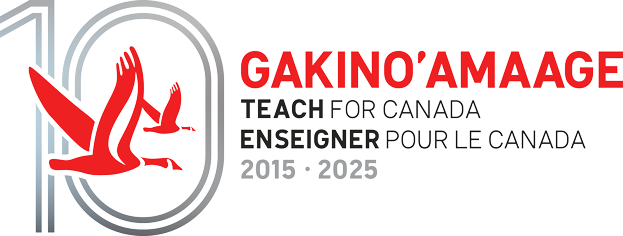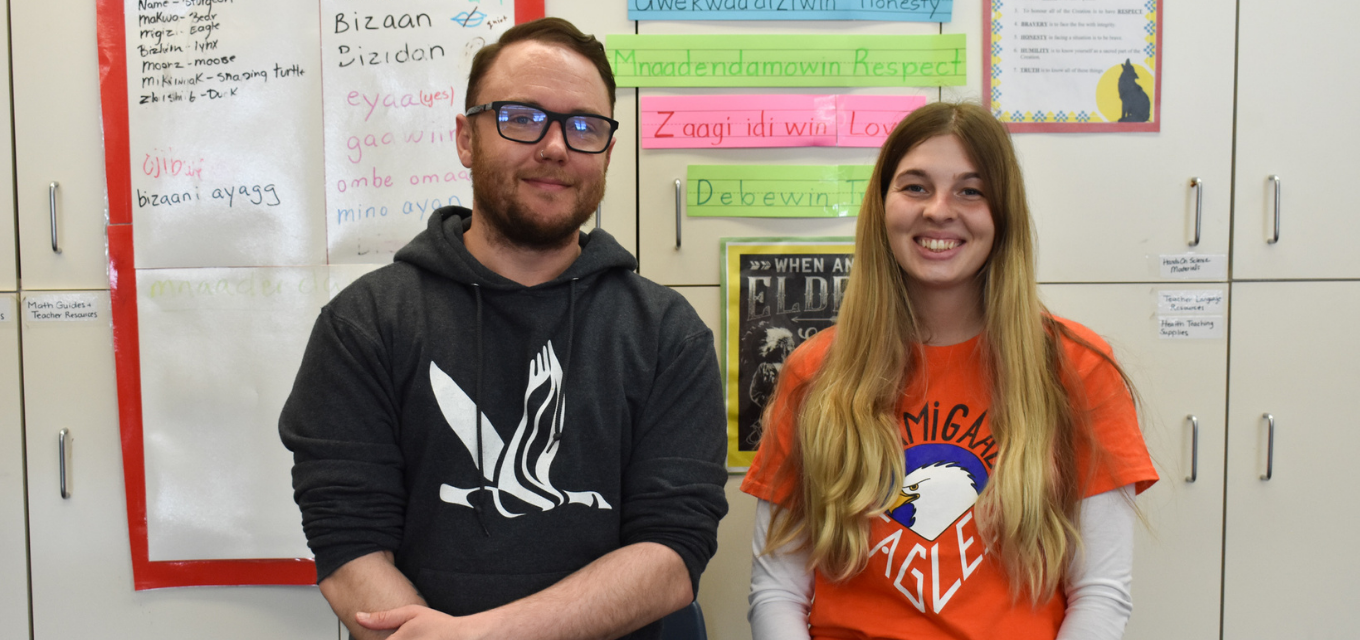Throughout the 2021-22 school year, Teach For Canada partnered with Trent University’s School of Education to offer a Northern Practicum Program. This program connects teacher candidates with short-term teaching placement opportunities in the First Nations that Teach For Canada serves, and is now a permanent program offering, being carried into the 2022-23 school year and beyond.
The program provides meaningful educational experience in a northern classroom, where aspiring teachers can deepen their understanding of Indigenous ways of being, gain professional experience, and familiarize themselves with initiatives that they can later integrate into their lessons.
Leah Morrow is a Teacher Candidate at Trent University, and participant in Teach For Canada’s 2022 Northern Practicum Program, who completed her fourth and final teaching placement at Pegamigaabo School in Big Grassy River First Nation. We sat down with Leah while she was taking part in the practicum to hear about her reasons for going North, as well as her experience teaching at Pegamigaabo.
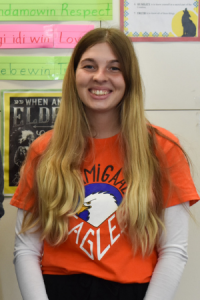
Leah Morrow is a Teacher Candidate at Trent University, and a participant in Teach For Canada’s 2022 Northern Practicum Program. Leah completed a four-week practicum at Pegamigaabo School in Big Grassy River First Nation.
Applying to the Northern Practicum Program
Leah first heard about Teach For Canada’s Northern Practicum Program through an email from Nicole Bell. Dr. Bell is Anishinaabe (bear clan) from Kitigan Zibi First Nation, and is an Associate Professor, Senior Indigenous Advisor in the School of Education and Professional Learning at Trent University. The email introduced the Northern Practicum Program and invited those interested in participating to apply.
Leah had always thought that she wanted to teach in an Indigenous community, but never knew how to go about it.
“There had never been a clear path. Once I heard about Teach For Canada, I had found a reason, and a way to go North.”
Leah expressed her interest and later attended an information session co-hosted by Trent’s School of Education and Teach For Canada. Teacher candidates then took part in interviews to determine whether they would be selected for the program.
“During the interview, Dr. Bell asked about my experience with First Nations culture, and my connection to the land. She also wanted to know about my self care practices, and mental health hygiene. I was asked why I wanted to teach in the North and whether there was potential for me to extend my time there, and teach in a First Nation once certified.”
What drew Leah to work in a northern First Nation?
“I felt that the faculty here would have knowledge that stretched beyond what I could access in a Southern Ontario school. This experience would give me an opportunity to learn from students who live in other parts of the province.”
Leah was also interested in gaining experience with the needs of First Nation students. She was interested in the specialized skills required to support their success, and learning strategies to make her students into better learners.
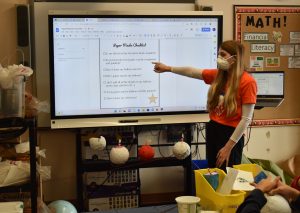
Leah leading a paper mache lesson with her class.
What surprises new teachers to the North the most?
Freedom to teach outdoors
Small class sizes
The ability to try new things and creatively expand upon the curriculum
Daily collaboration with other faculty members
Prior to teaching in Big Grassy River, Leah’s placements had been in Southern Ontario, in the Kawartha Pineridge School Board, at Bowmanville Highschool, Crestwood Intermediate and Secondary School, and Colbert Collegiate.
Participants in the Northern Practicum Program gain meaningful experience teaching in a First Nation classroom, while helping to fulfill the short-term staffing needs of Indigenous communities. Teach For Canada’s Northern Practicum Program allows participants to share their gifts, hone their craft, and gain hands-on teaching experience, all while finding out whether the North is the right fit for them.
What Leah learned throughout the Northern Practicum Program
“Since coming to Pegamigaabo, I have learned that teaching takes more of a backseat to meeting the needs of students in other areas of their lives. My experience has taught me that children need someone to care for the whole child.”
“Leah has brought a lot of passion with her to Big Grassy River,” says Beth Shaw, a Teach For Canada educator who was matched with Leah for her four-week practicum, “Since Leah is still in teachers college, she is constantly learning. She brings a passion for learning with her, which is always a benefit when you are teaching. Students see value in what you think is valuable, and having enthusiasm can encourage them to deepen their learning even further.”

Beth Shaw, a Teach For Canada educator and Trent University alumni, is a teacher in Big Grassy River First Nation, and was matched with Leah for her four-week practicum.
When asked what approach Leah had taken throughout her practicum, Beth pointed out her willingness to listen, learn, and step into a new environment. “Her flexibility and willingness to ebb and flow with the changes that happen in a First Nation school is important. Not everything goes the way that we anticipate, so flexibility is very important in the North”.
“Beth is awesome. She’s been very open. Karen, another Teach For Canada alumni, is a second mentor in the school who I have learned from since beginning my journey in Big Grassy River.
“Nothing is off the table. I know that I can ask them anything”.
Beth Shaw is an alumni of Trent’s Bachelor of Education program, and graduated in 2018. “We were able to connect on those similarities,” says Beth of Leah. “We have had some of the same teachers, and we’ve also been able to connect through math. Leah came into the classroom thinking that math wasn’t her strong suit, and I remember feeling that way when I began teaching, too. It has been great to see her get out of her comfort zone.”
“Beth has encouraged me to try new things in my lessons–she has given me the freedom to explore new ideas, and if something doesn’t work, that’s okay.”
Beth expressed that mutual respect is important to achieving a successful teaching placement. “It’s understood that we work collaboratively on lessons. We work together to brainstorm ideas, and find a balance that we are comfortable with. The outcome of this collaboration is that we’re now offering a language unit, and an art lesson with a focus on paper mache.”
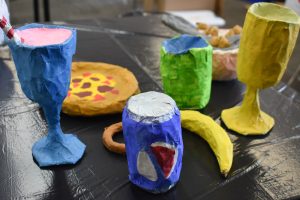
Beth and Leah led their class in a paper mache project, where students were tasked on making representations of their favourite foods.
Before leaving Leah and Beth’s class for the afternoon, Leah and Beth shared their advice for someone thinking about teaching in a First Nation.
Leah: “If you want to do it, go for it. If you even have that thought–that curiosity–see it through. Teaching in the North is a great opportunity. The faculty and school has been welcoming, and amazing.
“It can be intimidating to walk into a community that is not your own, but Big Grassy River has been really great.”
– Leah Morrow
Beth: “Teaching in a First Nation allows you to make meaningful connections that I have not been able to experience anywhere else. This community-based learning opportunity, and feeling like you are connecting with those around you on a deeper level, is something that you don’t always get with teaching. It makes you grow as an educator at a quicker pace, and has given me a lot of confidence in my abilities. This is my third year here, and it’s been the best teaching experience ever.”
“If you feel a pull or draw to teach in the North, honour that. It might open doors for you that you didn’t think were possible.”
– Beth Shaw
Teach For Canada is currently seeking partnerships with Canadian universities to offer our Northern Practicum Program. Join us to help support teacher candidates in gaining meaningful experience teaching in First Nation schools. Click here for information.
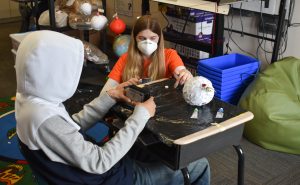
Leah Morrow works with a student at Pegamigaabo School.


